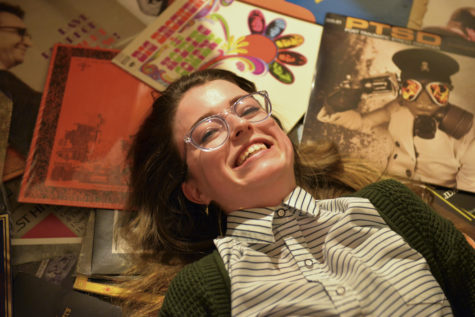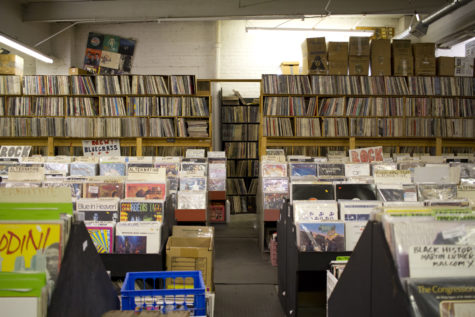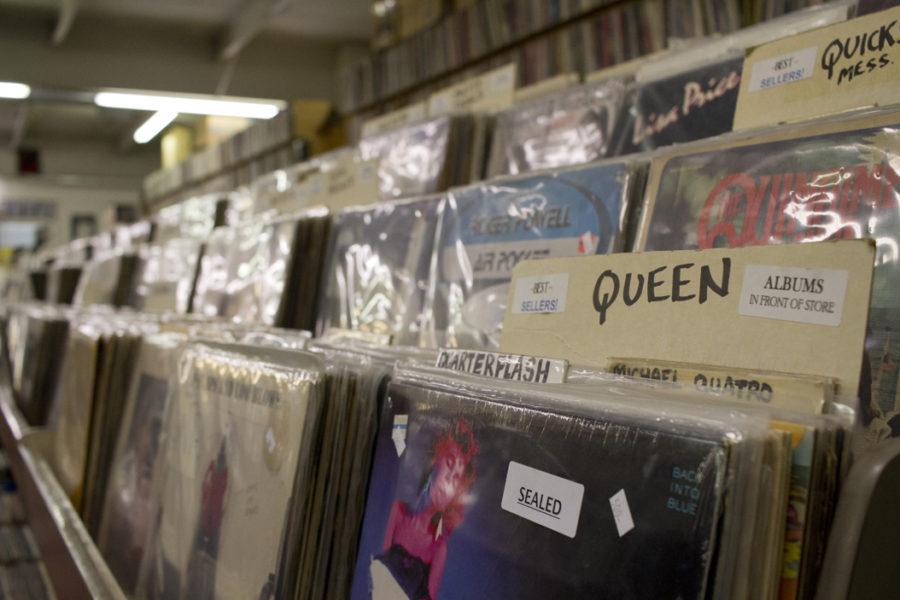Cassette tapes, eight-tracks and Walkmans may be things of the past, but not vinyl. In the last decade, records have been making a considerable comeback. A large factor to the recent vinyl resurgence? Young adults.
Although digital music streaming services such as Spotify, Apple Music, Pandora and Tidal have become increasingly prominent over the past few years, vinyl sales have been on the rise since nearly disappearing in the early 2000s. Vinyl LP/EP sales rose 32 percent in 2015 to $416 million, generating more revenue than ad-supported streaming services, which grew 31 percent to only $385 million, according to Pitchfork.
Jerry Weber, owner of Jerry’s Records in Squirrel Hill for more than 33 years, said the trend — beginning in about 2012 — of teenagers and young adults buying vinyl is what’s continuing to allow his business to thrive after so many years.
Weber sits behind the cash register, pricing newly arrived used records — most of them from people who came to the shop to sell their records — while classic rock vinyl plays over the speakers in the background.
“Older people in their 50s and 60s built this business,” Weber said. “And now they don’t buy records anymore. It has flip-flopped to people buying records ages 15 to 35 — that’s the biggest flip-flop ever.”
Now, adults in their 50s to 70s don’t prioritize buying vinyl like young adults do. Weber said it’s common for adults to have more expenses to pay — bills, gas or children to pay for and take care of — that younger people generally don’t have to worry about.
Therefore the younger generation generally has more time and money to dedicate toward collecting and buying vinyl, especially with steep prices for new records from modern bands, such as Future Islands, Real Estate and Alt-J.
Records at Jerry’s often go for about $7 per used vinyl, while newly released vinyl is sold for $20 to $30, on average, according to Weber.
Weber said many of the younger generation’s parents grew up listening to classic rock, which they then introduced to their kids. Hearing that music on vinyl made the younger generation want to get their own record players and start collecting — which meant frequenting record stores.

Kayla Greygor, a senior communication and philosophy double major, said her parents were a big part of how she started to collect vinyl after they introduced it to her. Greygor, the promotions director at WPTS, soon found she was hooked on vinyl independently from her parents — primarily because of the interactive nature and shareability of vinyls. Not having her parents’ collection at school prompted her to curate records of her own.
Her collection grew massively over the four years since she started, expanding the most during this past year from shopping at different stores around Pittsburgh. She has both new and used vinyl from the bands No Doubt, The Zombies and Quasimoto.
“I started my own record collection separate from my parents’ in my senior year of high school. I liked the idea of being able to pass records around. It’s totally different and more special to me, rather than just listening to the new stuff on Spotify,” Greygor said.
With technology advancing so rapidly, Greygor — along with many other young adults — is trying to cling to the past through vinyl.
“This comeback is making teens realize that we now have the ability to collect vinyl, take polaroid pictures, etc., like our parents did, but now it’s actually cool and trendy,” Greygor said.
With the emergence of CDs in the early 1990s, record companies did not want to give people the option to buy either vinyl or CD. According to Jim Johnson, who does sales and marketing for the music distributor Alliance Entertainment in Florida, the record companies wanted the public to adapt and spend their money on the new CD music format at that time, a phenomenon Fred Bohn Jr. witnessed as well.
While some fathers were passing on individual records, Bohn’s dad gave him an entire record store. Bohn’s father opened his Millvale store, The Attic, in 1980.
“If the record companies weren’t pushing CDs in the early 2000s, records would have never went out — but the record companies didn’t want to give you that option,” Bohn said.

Although vinyl sales are at an all-time high since 1988, CD sales are rapidly declining, but Johnson said he is absolutely sure they will never go away. Unless a new physical format comes out to replace CDs, he thinks they will always be viable to sell because older music has now become exceptionally cheap on CD.
“Downloads have had a big effect on the music industry, but people still like to own something that they can look at, and, on that piece of music, read about who plays on what, who wrote the songs — people like getting all that information. That’s not always what you get with the downloads,” Johnson said.
In the midst of the youth movement toward vinyl, Weber has seen a more specific trend: an increasing number of young women buying records, particularly with girls in college and in their 20s.
“It used to be that a girl would come in walking behind her guy and carrying the records for him — women didn’t buy a lot of records, even going back 10 to 20 years ago,” Weber said.
Greygor models this trend and said nostalgia, as well as the process of browsing her albums and choosing which one she wants to listen to, are the major appeals of vinyl.
“You are able to watch the record spin while you’re listening to it and have to physically flip the record over to hear the rest of the songs on the other side,” Greygor said. “You’re not just shuffling your iPod.”
Connor Murray, Pitt first-year marketing major and founder of the record label Crafted Sounds, said buying records is very appealing to him because he is able to have music that is tangible. Murray chooses to spend his money on vinyl because he physically wants the music — he doesn’t just want to listen to it on Spotify.
As the founder of a record label, which he started because of his own interest in making music, Murray is starting relationships with many local artists, and he aims to support these artists through vinyl sales.
“A lot of record sales go to the bands, so buying those vinyls is a big help for them. Also, I feel like you definitely get a better engagement with the artists themselves when you buy the record. Almost all music can be accessed online nowadays, so buying it in person in physical format means you care, which is rad,” Murray said.
But the trend isn’t just limited to walk-ins at record stores across the city. Promotions such as Record Store Day, an annual event held on the last Saturday in April, highlight all types of music on vinyl, helping to spur millennials’ love for vinyl. A multitude of rare records are made for this international event with a different list of releases for each country.
“Vinyl is huge across all age groups,” Johnson said. “But with popular events like Record Store Day and many younger, hip bands releasing their music on records, it has really allowed vinyl to take off once again.”


